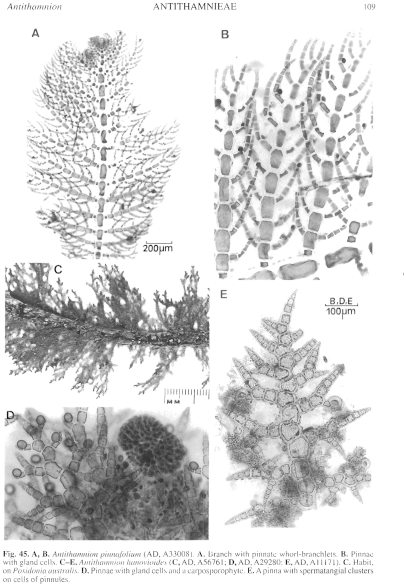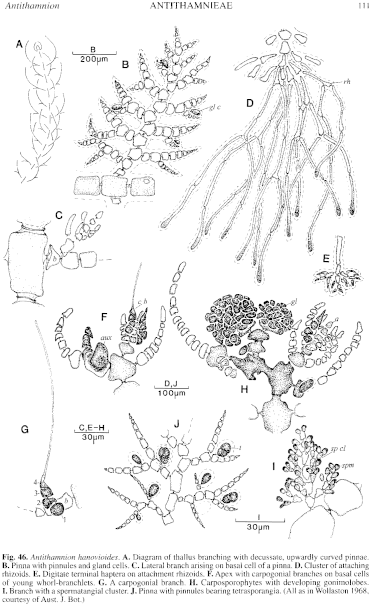|
|
|
|
|
|||||||||||
|
Electronic Flora of South Australia Species Fact Sheet
Phylum Rhodophyta – Order Ceramiales – Family Ceramiaceae – Tribe Antithamnieae
Selected citations: Huisman 1997: 196. Huisman & Walker 1990: 419. Lucas 1909: 51. Lucas & Perrin 1947: 352. Millar & Kraft 1993: 35. Silva et al. 1996: 378. Wollaston 1968: 295, fig. 19. Womersley 1950: 179.
Synonyms
Callithamnion hanovioides Sonder 1853: 674; 1855: 512; 1881: 10. J. Agardh 1876: 26. Harvey 1863, synop.: liv. Tate 1882: 16. Tisdall 1898: 502. Wilson 1892: 187.
Callithamnion spinescens sensu Harvey 1855a: 560 (NON Kützing 1843: 373; 1861: 28, pl. 88a-c).
Thallus (Figs 45C, 46A) medium to dark red-brown, with branched prostrate axes with more or less erect unattached ends 1–3 cm long, densely covered with pairs of opposite, decussate, whorl-branchlets (pinnae) which are upwardly curved and overlap. Attachment by branched clusters of rhizoids (Fig. 46D) from the basal cells of pinnae, with terminal digitate haptera (Fig. 46E); epiphytic on Posidonia, Amphibolis and various larger algae. Structure. Apical cells 8–15 µm in diameter and L/D 1–1.5, densely surrounded by young whorl-branchlets, increasing to 100–300 µm in diameter and L/D 1–1.5 in mature axial cells which have prominent pit-connections. Pinnae (Fig. 45D, E) rigid, distichously branched, (0.5–) 1–2 mm long, rachis cells 35–70 µm in diameter, basal cells L/D 0.8–1.2, then cells L/D 1.2–1.6, each cell bearing a single, alternate, usually branched pinnule, lower cells 25–55 µm in diameter and L/D 1–2, tapering near their apices to a mucronate end cell; gland cells (Fig. 45D, 46B) prominent, ovoid, borne on short 2–3-celled branches of the pinnules, 25–40 (–50) µm in diameter. Lateral branches occur irregularly, arising on the small basal cells of the pinnae (Fig. 46C). Cells uninucleate when small, probably multinucleate when larger; rhodoplasts discoid in small cells, becoming elongate and ribbon like in axial cells.
Reproduction: Gametophytes dioecious. Carpogonial branches (Fig. 46F, G) borne in series of 10–16 on basal cells of young pinnae, with axial elongation ceasing on development of the first carposporophyte, and pinnules usually absent on the rachides. Post-fertilization the supporting (basal) cell enlarges upwards and cuts off the auxiliary cell and fusion occurs via a connecting cell. Fusions occur between the axial cell, residual supporting cell and foot cell, and several gonimolobes (Fig. 46H) 150–550 (–900) µm across of ovoid-angular carposporangia 25–45 µm in diameter develop, protected by surrounding pinnae from lower axial cells (Fig. 45D). Spermatangia occur terminally on dense, branched, clusters (Fig. 45E, 46I) on the upper side of lower pinnule cells.
Tetrasporangia (Fig. 46J) occur on the pinnules or their branches, sessile, ovoid and 45–65 µm in diameter, decussately or cruciately divided.
Type from Gulf St Vincent, S. Aust.; holotype missing in MEL but Sonder's drawings (labelled "No. 43, P. Adelaide") and his description (as in 1853, p. 674) are present.
Selected specimens: Yanchep, W. Aust., on Amphibolis, drift (Womersley, 22.ix.1979; AD, A51276). Point Peron, W. Aust., on Amphibolis, in reef pools (Mitchell, 22.ix.1966; AD, A30754). Pearson Is, S. Aust., on Posidonia, 5 m deep (Shepherd & Turner, 28.iii. 1982; AD, A53041). Wanna, S. Aust., on Gigartina, drift (Womersley, 19.ii.1959; AD, A22390). Venus Bay, S. Aust., on Gelidium australe, drift (Womersley, 12.ii.1954; AD, A19494). West I., S. Aust., on Posidonia, 4–5 m deep (Shepherd, 20.ix.1985; AD, A56761 - "Marine Algae of southern Australia" No. 311). Penguin Rock, West I., S. Aust., epiphytic, 11 m deep (Kildea, 20.x.1996; AD, A66712). Victor Harbor, S. Aust., on Perithalia, drift (Womersley, 24.vii.1949; AD, A11171). Vivonne Bay, Kangaroo I., S. Aust., drift (Wollaston, 21.viii.1963; AD, A39318). Kangaroo Head, Kangaroo I., S. Aust., on Sargassum, 6 m deep (Lavers, 9.xii.1996; AD, A66832). Boatswain Point, Guichen Bay, S. Aust., on Laurencia data, drift (Wollaston, 17.v.1965; AD, A29280). Stinky Bay Point, Nora Creina, S. Aust., on Acrocarpia, 1–3 m deep (Miller, 26.x.1996; AD, A66770). Point Roadknight, Vic., on Perithalia, drift (Womersley, 13.iv.1994; AD, A63538). Walkerville, Vic., on Caulocystis cephalornithos, drift (Sinkora A2655, 23.xi.1979; AD, A61056). Gabo I., Vic. on hydroid. 1–3 m deep (Shepherd, 15.ii.1973; AD, A43381). Ulverstone, Tas., on Gelidium asperum, drift (Gordon, 18.i.1966; AD, A29987). Safety Cove, Port Arthur, Tas., on Cystophora xiphocarpa, 7 m deep (Brown & Kenchington, 16.x.1986; AD, A57740). Barranjoey Heads. N.S.W., on Cystophora, in pools (Skinner, 2.vi.1977; AD, A48102).
Distribution: Houtman Abrolhos, W. Aust. (Huisman 1997), to Barranjoey Heads, N.S.W., and around Tasmania.
Taxonomic notes: A. hanovioides is the most common species of Antithamnion on southern Australian coasts, epiphytic on a wide variety of larger algae and seagrasses. Callithamnion spinescens Kützing (1843, p. 373) from W. Aust. (Preiss) appears to be a distinct but little known species, but C. spinescens sensu Harvey (1855a, p. 560) is a synonym of A. hanovioides.
Silva et al. (1996, p. 378) point out that the original spelling of the species name, with a 'v' and not a 'w' should be followed.
References:
AGARDH, J.G. (1876). Species Genera et Ordines Algarum. Vol. 3, Part 1- Epicrisis systematic Floridearum, pp. i-vii, 1–724. (Weigel: Leipzig.)
DE TONI, G.B. (1903). Sylloge Algarum omnium hucusque Cognitarum. Vol. 4. Florideae. Sect. 3, pp. 775–1521 + 1523–1525. (Padua.)
HARVEY, W.H. (1855a). Some account of the marine botany of the colony of Western Australia. Trans. R. Jr. Acad. 22, 525–566.
HARVEY, W.H. (1863). Phycologia Australica. Vol. 5, Plates 241–300, synop., pp. i-lxxiii. (Reeve: London.)
HUISMAN, J.M. & WALKER, D.I. (1990). A catalogue of the marine plants of Rottnest Island, Western Australia, with notes on their distribution and biogeography. Kingia 1, 349–459.
HUISMAN, J.M. (1997). Marine Benthic Algae of the Houtman Abrolhos Islands, Western Australia. In Wells, F.E. (Ed.) The Marine Flora and Fauna of the Houtman Abrolhos Islands, Western Australia, pp. 177–237. (W. Aust. Museum: Perth.)
KÜTZING, F.T. (1843). Phycologia generalis. (Leipzig.)
LUCAS, A.H.S. & PERRIN, F. (1947). The Seaweeds of South Australia. Part 2. The Red Seaweeds. (Govt Printer: Adelaide.)
LUCAS, A.H.S. (1909). Revised list of the Fucoideae and Florideae of Australia. Proc. Linn. Soc. N.S.W. 34, 9–60.
MILLAR, A.J.K. & KRAFT, G.T. (1993). Catalogue of marine and freshwater Red Algae (Rhodophyta) of New South Wales, including Lord Howe Island, South-western Pacific. Aust. Syst. Bot. 6, 1–90.
SILVA, P.C., BASSON, P.W. & MOE, R.L. (1996). Catalogue of the Benthic Marine Algae of the Indian Ocean. (University of California Press: Berkeley, Los Angeles & London.)
SONDER, O.W. (1853). Plantae Muellerianae. Algae. Linnaea 25, 657–709.
SONDER, O.W. (1855). Algae annis 1852 et 1853 collectae. Linnaea 26, 506–528.
SONDER, O.W. (1881). In Mueller, F., Fragmenta Phytographiae Australiae. Supplementum ad volumen undecinum: Algae Australianae hactenus cognitae, pp. 1–42, 105–107. (Melbourne.)
TATE, R. (1882). A list of the charas, mosses, liverworts, lichens, fungs, and algals of extratropical South Australia. Trans. R. Soc. S. Aust. 4, 5–24.
TISDALL, H.T. (1898). The algae of Victoria. Rep. 7th Meet. Aust. Ass. Adv. Sci., Sydney, 1898, pp. 493–516.
WILSON, J.B. (1892). Catalogue of algae collected at or near Port Phillip Heads and Western Port. Proc. R. Soc. Vict. 4, 157–190.
WOLLASTON, E.M. (1968).Morphology and taxonomy of southern Australian genera of Crouanieae Schmitz (Ceramiaceae, Rhodophyta). Aust. J. Bot. 16, 217–417.
WOMERSLEY, H.B.S. (1950). The marine algae of Kangaroo Island. III. List of Species 1. Trans. R. Soc. S. Aust. 73, 137–197.
The Marine Benthic Flora of Southern Australia Part IIIC complete list of references.
Publication:
Womersley, H.B.S. (24 December, 1998)
The Marine Benthic Flora of Southern Australia
Rhodophyta. Part IIIC. Ceramiales – Ceramiaceae, Dasyaceae
©State Herbarium of South Australia, Government of South Australia
Illustrations in Womersley Part IIIA, 1998: FIGS 45 C–E, 46.

Figure 45 enlarge
Fig. 45. A, B. Antithamnion pinnafolium (AD, A33008). A. Branch with pinnate whorl-branchlets. B. Pinnae with gland cells. C–E. Antithamnion hanovioides (C, AD, A56761; D, AD, A29280; E, AD, A 11171). C. Habit, on Posidonia australis. D. Pinnae with gland cells and a carposporophyte. E. A pinna with spermatangial clusters on cells of pinnules.

Figure 46 enlarge
Fig. 46. Antithamnion hanovioides. A. Diagram of thallus branching with decussate, upwardly curved pinnae. B. Pinna with pinnules and gland cells. C. Lateral branch arising on basal cell of a pinna. D. Cluster of attaching rhizoids. E. Digitate terminal haptera on attachment rhizoids. F. Apex with carpogonial branches on basal cells of young whorl-branchlets. G. A carpogonial branch. H. Carposporophytes with developing gonimolobes. I. Branch with a spermatangial cluster. J. Pinna with pinnules bearing tetrasporangia. (All as in Wollaston 1968, courtesy of Aust. J. Bot.)

|
Email Contact: State Herbarium of South Australia |

|